Milford Haven: Difference between revisions
m clean up, typos fixed: labour intensive → labour-intensive, a 12th century → a 12th-century, 10 year → 10-year, as as → as |
m clean up, replaced: medieval → mediæval (3) |
||
| Line 49: | Line 49: | ||
Parts of the Haven are within the Pembrokeshire Coast National Park. The northern side is within the Preseli Environmentally Sensitive Area. The area includes: Angle Bay, Carew and Cresswell Rivers, Cosheston Pill, Daugleddau, Gann Estuary, Pembroke River, Pwllcrochan Flats and West Williamston Quarries Sites of Special Scientific Interest; Carew, [[Haverfordwest]], [[Llangwm, Pembrokeshire|Llangwm]], Milford Haven, [[Neyland]], [[Pembroke]] and [[Pembroke Dock]] (Royal Dockyard) Conservation Areas.<ref name="CCW"/> | Parts of the Haven are within the Pembrokeshire Coast National Park. The northern side is within the Preseli Environmentally Sensitive Area. The area includes: Angle Bay, Carew and Cresswell Rivers, Cosheston Pill, Daugleddau, Gann Estuary, Pembroke River, Pwllcrochan Flats and West Williamston Quarries Sites of Special Scientific Interest; Carew, [[Haverfordwest]], [[Llangwm, Pembrokeshire|Llangwm]], Milford Haven, [[Neyland]], [[Pembroke]] and [[Pembroke Dock]] (Royal Dockyard) Conservation Areas.<ref name="CCW"/> | ||
The littoral landscape of Milford Haven shows evidence of maritime conquest, settlement, commerce, fishing and defence from the 11th century to the 20th century. Iron Age promontory forts are sited on several of the headlands at the entrance and along the course of the Haven and the Daugleddau. Early | The littoral landscape of Milford Haven shows evidence of maritime conquest, settlement, commerce, fishing and defence from the 11th century to the 20th century. Iron Age promontory forts are sited on several of the headlands at the entrance and along the course of the Haven and the Daugleddau. Early mediæval, Christian and Viking sites are evidenced by place-names, documentary and epigraphic evidence, such as Early Christian Inscribed Stone monuments. The Norman conquest, achieved by coastally-sited castle boroughs, has left its distinctive mark signs at Pembroke, at Haverfordwest, and at Carew. Carew did not develop into a borough, but excavations have shown that a Dark Age stronghold and possible Romano-British site preceded the Norman castle.<ref name="CCW"/> | ||
At the turn of the 18th and 19th centuries, two new towns were constructed: Milford in 1790 by Sir William Hamilton, and Pembroke Dock in 1802 as the site for a new Royal Naval Dockyard. Both towns have regular planned layouts, both have experienced a history of boom and slump in shipbuilding, fishing and as railheads and ocean terminals.<ref name="CCW"/> These two towns, which could handle the larger vessels then entering service, concentrated trade that had previously been dispersed at quays, jetties and landing places and small settlements further up river.<ref name="CCW"/> These small ports served the coal mines of the Pembrokeshire Coalfield located on both shores of the Daugleddau, and also the large limestone quarries at West Williamston. The Daugleddau ports flourished in the 16th, 17th and 18th centuries, but continued to work through the 19th century by changing to using barges to tranship cargoes down river to bigger vessels at the mid-Haven ports.<ref name="CCW"/> | At the turn of the 18th and 19th centuries, two new towns were constructed: Milford in 1790 by Sir William Hamilton, and Pembroke Dock in 1802 as the site for a new Royal Naval Dockyard. Both towns have regular planned layouts, both have experienced a history of boom and slump in shipbuilding, fishing and as railheads and ocean terminals.<ref name="CCW"/> These two towns, which could handle the larger vessels then entering service, concentrated trade that had previously been dispersed at quays, jetties and landing places and small settlements further up river.<ref name="CCW"/> These small ports served the coal mines of the Pembrokeshire Coalfield located on both shores of the Daugleddau, and also the large limestone quarries at West Williamston. The Daugleddau ports flourished in the 16th, 17th and 18th centuries, but continued to work through the 19th century by changing to using barges to tranship cargoes down river to bigger vessels at the mid-Haven ports.<ref name="CCW"/> | ||
| Line 85: | Line 85: | ||
===Foundation of a new town=== | ===Foundation of a new town=== | ||
By the late 18th century, the two creeks which would delimit the future town of Milford's boundaries to the east and west, namely Hakin and Castle Pill, were being used as harbours for ships to load and unload coal, corn and limestone.,<ref>[http://www.field-studies-council.org/fieldstudies/documents/vol2.1_33.pdf George, Barbara J; ''Pembrokeshire Sea Trading Before 1900''] Field Studies Journal; Pg, 5-6; Retrieved 19 January 2010</ref> A ferry service to Ireland operated from Hakin at the turn of the century, although this ceased in the early 19th century.<ref name="McKay"/> Although surrounding settlements at [[Steynton]], [[Thornton, Pembrokeshire|Thornton]], Priory, Liddeston and [[Hubberston]]/Hakin were established, they were little more than hamlets. The only man-made structures on the future site of Milford were the | By the late 18th century, the two creeks which would delimit the future town of Milford's boundaries to the east and west, namely Hakin and Castle Pill, were being used as harbours for ships to load and unload coal, corn and limestone.,<ref>[http://www.field-studies-council.org/fieldstudies/documents/vol2.1_33.pdf George, Barbara J; ''Pembrokeshire Sea Trading Before 1900''] Field Studies Journal; Pg, 5-6; Retrieved 19 January 2010</ref> A ferry service to Ireland operated from Hakin at the turn of the century, although this ceased in the early 19th century.<ref name="McKay"/> Although surrounding settlements at [[Steynton]], [[Thornton, Pembrokeshire|Thornton]], Priory, Liddeston and [[Hubberston]]/Hakin were established, they were little more than hamlets. The only man-made structures on the future site of Milford were the mediæval chapel, and Summer Hill Farm, and its accompanying cottages.<ref name="McKay"/> | ||
[[File:Milford Gastineau.jpg|thumb|left|Engraving of Milford in 1829 by Henry G Gastineau]] | [[File:Milford Gastineau.jpg|thumb|left|Engraving of Milford in 1829 by Henry G Gastineau]] | ||
Latest revision as of 09:22, 30 January 2021
| Milford Haven Welsh: Aberdaugleddau | |
| Pembrokeshire | |
|---|---|
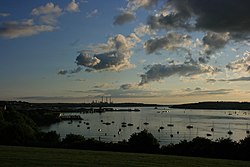 Milford Haven sunset | |
| Location | |
| Grid reference: | SM899061 |
| Location: | 51°42’51"N, 5°2’34"W |
| Data | |
| Population: | 13,096 |
| Post town: | Milford Haven |
| Postcode: | SA73 |
| Dialling code: | 01646 |
| Local Government | |
| Council: | Pembrokeshire |
| Parliamentary constituency: |
Preseli Pembrokeshire |
Milford Haven is a major commercial port town in Pembrokeshire. It stands on the north side of the Milford Haven Waterway, a natural harbour used as a port since the Middle Ages.
The town was founded in 1790 on the north side of the Waterway, from which it takes its name. Designed to a grid pattern, it was originally intended by the founder, Sir William Hamilton, to be a whaling centre, though by 1797 it was developing as a Royal Navy dockyard which it remained until the dockyard was transferred to Pembroke in 1814. It then became a commercial dock, with the focus moving in the 1960s, after the construction of an oil refinery built by the Esso Company, to logistics for fuel oil and liquid gas. By 2010 the town's port has become the fourth largest in the United Kingdom in terms of tonnage,[1] and plays an important role in the United Kingdom's energy sector with several oil refineries and one of the biggest LNG terminals in the world.
Milford Haven is the second largest town in Pembrokeshire, with a population of 12,830. The administrative community of the same name takes in the town of Milford Haven and some of the surrounding villages, including Hakin, Hubberston, Liddeston, and Steynton.
The water of Milford Haven has long been known as a safe port and this quality was the foundation of the town, for while the town itself is an eighteenth century creation, the name of Milford Haven has been famed for a thousand years as a commercial and military harbour which played its part in campaigns from the days of Henry II's to modernity.
Name of the haven and the town
Milford Haven is an Anglicization of an Old Norse name "Melrfjordr" that was first applied to the waterway, meaning "sandbank fjord" (inlet), developing into "Milford". "Haven" appeared later, marking its status as a sheltered port.
The town was first named "Milford" after the waterway, and it assumed the word Haven later, in this case around 1868, when the railway terminus was built.[2]
The town's Welsh name is Aberdaugleddau, meaning "mouth of the two Rivers Cleddau", which refers to the waterway in the midst of Pembrokeshire into which are poured the "White River Cleddau" and the "Black River Cleddau". Cleddau itself may make reference to the action of a weapon or tool cutting through the land.[3]
Geography
Milford Haven the waterway is a ria or drowned valley.[4] The town of Milford Haven lies on the north bank. This is a landscape of low-lying wooded shorelines, creeks and mudflats.[5] There has been a great deal of loss and degradation of local mudflat habitat as a result of industrial and commercial development - one study indicated a 45% loss in Hubberston Pill.[6]
The town itself has a historic core from the late 18th and 19th centuries, based on a grid pattern, located between Hubberston Pill and Castle Pill and extending inland for 500 yards. Milford Haven's 20th century expansion took in several other settlements.[7] Hakin and Hubberston are older, and situated to the west of the main town. Steynton is a mediæval village to the north, no longer separated due to the expansion of houses. Lower Priory, with the remains of a very early religious priory, is located in a natural valley near the village of Thornton.
Milford Haven enjoys a mild climate. Its proximity to the coast contributes to wet winters, but it enjoys a generous amount of sunshine with over 1,800 hours of sunshine a year recorded for the nearby village of Dale.[8]

The Waterway
See also River Cleddau
Milford Haven Waterway (to distinguish it from the town which has assumed its name) is a natural deep-water harbour reaching deep into Pembrokeshire. The Haven is a ria or drowned valley flooded at the end of the last Ice Age formed by the Pembroke River and the Daugleddau estuary, and it winds westward to the sea. As one of the deepest natural harbours in the world, it is a busy shipping channel, trafficked by ferries from Pembroke Dock to Ireland, oil tankers and pleasure craft. Admiral Horatio Nelson, visiting the harbour with the Hamiltons, described it as the next best natural harbour to Trincomalee in Ceylon and "the finest port in Christendom".[9]
Coastal landscape
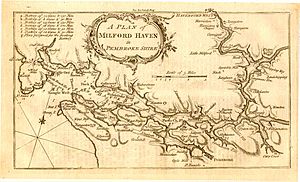
Parts of the Haven are within the Pembrokeshire Coast National Park. The northern side is within the Preseli Environmentally Sensitive Area. The area includes: Angle Bay, Carew and Cresswell Rivers, Cosheston Pill, Daugleddau, Gann Estuary, Pembroke River, Pwllcrochan Flats and West Williamston Quarries Sites of Special Scientific Interest; Carew, Haverfordwest, Llangwm, Milford Haven, Neyland, Pembroke and Pembroke Dock (Royal Dockyard) Conservation Areas.[4]
The littoral landscape of Milford Haven shows evidence of maritime conquest, settlement, commerce, fishing and defence from the 11th century to the 20th century. Iron Age promontory forts are sited on several of the headlands at the entrance and along the course of the Haven and the Daugleddau. Early mediæval, Christian and Viking sites are evidenced by place-names, documentary and epigraphic evidence, such as Early Christian Inscribed Stone monuments. The Norman conquest, achieved by coastally-sited castle boroughs, has left its distinctive mark signs at Pembroke, at Haverfordwest, and at Carew. Carew did not develop into a borough, but excavations have shown that a Dark Age stronghold and possible Romano-British site preceded the Norman castle.[4]
At the turn of the 18th and 19th centuries, two new towns were constructed: Milford in 1790 by Sir William Hamilton, and Pembroke Dock in 1802 as the site for a new Royal Naval Dockyard. Both towns have regular planned layouts, both have experienced a history of boom and slump in shipbuilding, fishing and as railheads and ocean terminals.[4] These two towns, which could handle the larger vessels then entering service, concentrated trade that had previously been dispersed at quays, jetties and landing places and small settlements further up river.[4] These small ports served the coal mines of the Pembrokeshire Coalfield located on both shores of the Daugleddau, and also the large limestone quarries at West Williamston. The Daugleddau ports flourished in the 16th, 17th and 18th centuries, but continued to work through the 19th century by changing to using barges to tranship cargoes down river to bigger vessels at the mid-Haven ports.[4]
In the late 19th century, concerns about the potential threat posed by the French Navy prompted the construction of a number of Palmerston Forts at various strategically important coastal sites, including Milford Haven. Most of the forts are now disused.[4] The late 20th century brought the jetties, oil terminals and shore processing facilities of the oil and power industries. This industry reached its zenith in the 1970s when Middle Eastern supply difficulties forced oil transport to use ocean routes and Very Large Crude Carriers for which the Haven, with its deep waters and westerly position, was particularly suited.[4]
History
Sir William Hamilton acquired the land on the north shore of Milford Haven from his wife, Catherine Barlow of Slebech[9] and here he determined to found a new town of Milford. The town of Milford was founded in 1793, after Sir William obtained an Act of Parliament in 1790 to establish the port here. The harbour though has a history going back many centuries earlier, as a shelter by Vikings and as a staging point on sea journeys to Ireland. Here began Henry II's invasion of Ireland in 1171, and Oliver Cromwell's own advance into Ireland in 1649.[10] Forces have come the other way too, such as Jean II de Rieux's 1405 reinforcement of the Glyndŵr Rising and in 1485 the landing of Henry Tudor Duke of Richmond before his march into England to Bosworth Field on whose bloody turf he became Henry VII.
Dark and Middle Ages
From the 790s until the cming of the Normans, Milford Haven was known by Vikings seeking shelter. During one visit in 854, the Viking Chieftain Hubba wintered in the Haven with 23 ships, eventually lending his name to the district of Hubberston.[11] Evidence of metal working in the area was recently excavated, suggesting a level of industrialization in the period 750 - 1100.[12]
A Benedictine priory was established at the head of Hubberston Pill in 1170, as a daughter house of St Dogmaels Abbey. Built on virgin land, it stood alongside the priory on Caldey Island as part of the Tironian Order in West Wales, and was dedicated to St Budoc.[13] Founded by Adam de Rupe, it stood until the Dissolution under King Henry VIII.[14]
In 1171, Henry II designated the area the rendezvous for his Irish expedition. An army of 400 warships, 500 knights and 4,000 men-at-arms gathered in the haven before sailing to Waterford, and on to Dublin; the first time an English king had stood on Irish soil, and the beginning of Henry's conquest of Ireland. In 1180 was built a chapel dedicated to St Thomas a Becket (whom Henry had slain); the chapel looked out over the Haven from the north shore. In later years it was used as a beacon for sailors in foul weather,[15] and ultimately as a pig sty, until it was reconsecrated in the 20th century.
Modern age
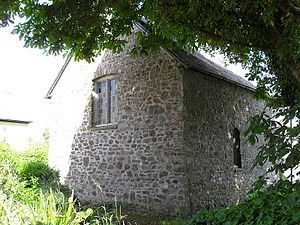
The land comprising the site of Milford, the Manor of Hubberston and Pill, was acquired by the Barlow family following the dissolution of the monasteries in the mid-16th century.
In Shakespeare's Cymbeline (1611), Imogen says:
He is at Milford-Haven: read, and tell me
How far 'tis thither.
- and
... how far it is
To this same blessed Milford: and by the way Tell me how Wales was made so happy as To inherit such a haven[16]
By 1590, two forts had been built to defend the entrance to the harbour[17] George Owen of Henllys, in his Description of Penbrokshire, claimed in 1603 that Milford Haven was the most famous port of Christendom.[18] The area however was a source of anxiety for the Tudor monarchy. Due to its location, it was exposed to attacks from Ireland, a convenient base from which England could be invaded.[19] In 1405, the French landed in force having left Brest in July with more than twenty-eight hundred knights and men-at-arms led by Jean II de Rieux, the Marshal of France, in order to support Owain Glyndŵr's rebellion. It was here that Henry Tudor Duke of Richmond landed with his uncle, Jasper Tudor, in 1485 before his march towards Lincolnshire, ending in the Battle of Bosworth.
In April 1603, Martin Pring used the Haven as his departure point for his exploratory voyage to Virginia.[20]
The haven acquired an additional strategic importance in the 17th century as a Royalist military base. Charles I ordered a fort to be built at Pill which could prevent re-enforcement of the Parliamentarian garrison of Pembroke Castle, and this was completed in 1643. On the 23 February 1644, a Parliamentarian force led by Rowland Laugharne crossed the Haven and landed at Castle Pill. The fort was gunned from both land and water, and a garrison was placed in Steynton church to prevent a Royalist attack from the garrison at Haverfordwest. The fort was eventually surrendered, and quickly taken,[21] along with St Thomas a Becket chapel. Just five years later in 1649 Milford Haven was again the site of Parliamentarian interest when it was chosen as the embarkation site for Oliver Cromwell's expedition to Ireland. Cromwell arrived in the Haven on 4 August, meeting George Monck,[10] before Cromwell and over a hundred crafts left for Dublin on 15 August.[22]
Foundation of a new town
By the late 18th century, the two creeks which would delimit the future town of Milford's boundaries to the east and west, namely Hakin and Castle Pill, were being used as harbours for ships to load and unload coal, corn and limestone.,[23] A ferry service to Ireland operated from Hakin at the turn of the century, although this ceased in the early 19th century.[9] Although surrounding settlements at Steynton, Thornton, Priory, Liddeston and Hubberston/Hakin were established, they were little more than hamlets. The only man-made structures on the future site of Milford were the mediæval chapel, and Summer Hill Farm, and its accompanying cottages.[9]
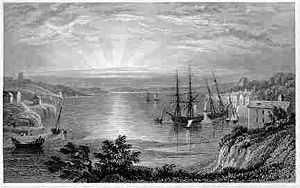
Sir William Hamilton's new town of Milford was founded in 1793 by the authority of a private Act of Parliament. Sir William's nephew, the Hon Charles Francis Greville, invited seven Quaker families from America, from Nantucket and Martha's Vineyard, to settle in the new town and develop a whaling fleet.[24][25] Then in 1797, he persuaded the Navy Board to create a dockyard for building warships.[24][26] Seven royal vessels were eventually launched from the dockyard, including HMS Surprise and HMS Milford.[27] The town was built on a grid pattern, thought to have been to the design of Jean Louise Barrallier, who was in charge of building the harbour.[28][29]
A church was consecrated in October 1808 and dedicated to St Catherine of Alexandria in the underdeveloped eastern side of the town, it remained a chapel of ease until 1891 when Milford became a parish, until that time competing with St Peter and St Cewydd in Steynton.[9] By the turn of the century, a mail coach was operating between London and Hubberston,[30] and in 1800 the short lived Milford and Pembrokeshire Bank was established by Thomas Phillips, operating from a branch in the town. It collapsed in 1810.[31]
In 1814 the Royal Dockyard was transferred to Pembroke Dock;[32] though, when Robert Fulke Greville inherited the estate in 1824, a commercial dock was started which became the home of a successful fishing industry.[33] By 1849, the district of Hakin was described as a considerable centre of boat building,[34] and by 1906, Milford had become the sixth largest fishing port in the British Isles, and its population rose. The Pembrokeshire Herald claimed in 1912 that "the fish trade is Milford's sole industry....the population of the town has doubled by means of it".
In 1863, the railway network came to Milford, linking it to the Haverfordwest line and beyond. In 1866, work was completed on an additional extension which provided access to the docks and mining depot on the eastern side of the town.[35] Between 1875 and 1886 The Great Eastern was a permanent fixture at Milford Docks, remaining there for lengthy repairs.[36] Her arrival into the docks was heralded as an example of the scale of vessel which the town could expect to attract.[9]
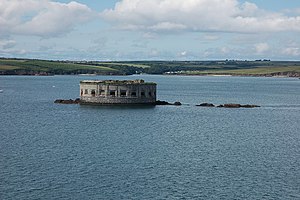
In the late 1850s, work began on a network of forts on both sides of the Milford Haven estuary, as a direct result of the Royal Commission on the Defence of the United Kingdom. They were designed with the intention of defending the United Kingdom against French invasion, although were never used for this purpose. Notable examples in the town were Fort Hubberstone in Gelliswick and Scoveston Fort to the north east of the town.[37][38]
Twentieth century and beyond
By 1901, the town's population had reached 5,102, and by 1931 had doubled to 10,104.[39] The early 20th century saw a period of increased urbanization of the area; in the period from the First World War to 1937, 312 council houses were built, and public services, such as electricity supplies and sewerage, were completed.[9] The steep gradient of the Rath was at this time constructed, and in 1939 a Town Hall was opened on Hamilton Terrace, at that time possessing an inbuilt fire station. 1939 also saw the opening of an outdoor swimming pool on the Rath.[9]
During the Second World War Milford Haven was chosen as a base for allied American troops, and roughly 1,000 American military personnel were housed in the town at this time. They manned an amphibious base which included a hospital built in Hakin and a docks complex at Newton Noyes. The base had a complement of 71 officers and 902 enlisted men, and played a role in preparations for D Day.[40] Despite its strategic importance as the home of a large fish market, a mines depot, a flax factory, and housing numerous military personnel, Milford escaped serious damage from German bombings during the Second World War. In the summer of 1941 a bomb fell in fields near Priory Road, and later that year, a bomb damaged a house in Brooke Avenue. In neither instance were there casualties.[41]
In 1960, the Esso Company completed work on an oil refinery near the town. This was followed by similar developments by many other chief oil companies in a 10-year period. In 1974, Milford could boast an oil trade of 58,554,000 tons, which was three times the combined trade of all the other ports of Wales. In 1996 the area hit the headlines internationally when the oil tanker Sea Empress ran aground, causing a substantial oil spill.[42]
By the early 1980s, the Esso refinery was the second largest in the United Kingdom.[43]
Shipping port
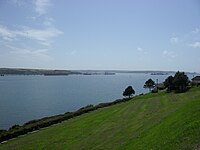
Milford Haven has the largest port in Wales, and the third largest port in the United Kingdom.[44] Shipping operations in Milford Haven are managed by the independent Milford Haven Port Authority as a trust port. The port authority has responsibility for managing Milford Docks, Milford Marina and Pembroke Port and Ferry Terminal.
Petro-Chemical
Milford Haven's association with the petro-chemical industry started with the opening of the first oil terminal and oil refinery in 1960; unfortunately there was a serious oil-spill from Esso Portsmouth, the first oil tanker to unload there. Since then, there have been numerous spills of varying magnitude, providing the port authority with a great deal of experience. Uniquely at the time, the harbourmaster instituted the principle of cleaning up first and allocating the blame (and the responsibility of paying for it) later. There are two large oil refineries nearby which represent one fifth of the United Kingdom's oil refining capacity.
In 1996, it was the location of the Sea Empress oil spill, initially thought to be one of the most devastating oil tanker disasters the UK has ever seen. In the event, recovery has been surprisingly good, perhaps partly because of the very strong tides. The comparable Torrey Canyon spill in 1968, a ship which had been heading to Milford Haven, affected shores further south around southern Cornwall and northern France, was actually far more damaging.
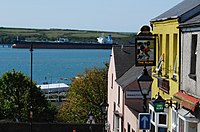
LNG
In light of the dwindling supplies of North Sea gas, Milford Haven has become home to two new LNG terminals which eventually could provide 25% of Britain's gas requirement. Under construction from 2006, South Hook is based on the former Esso refinery facility, while Dragon is based on a brownfield site. The regasified natural gas is to be fed through National Grid plc's South Wales Gas Pipeline to the distribution point at Tirley, Gloucestershire. The first vessel, the Q-Flex-class Tembek from Qatar, docked at South Hook on 20 March 2009.[45]
Cruise terminal
The port authority started promoting Pembrokeshire as a cruise destination in 2003 and passenger numbers have steadily increased since then. In July 2008, the first transatlantic Ocean liner|liner, the Maasdam arrived in Milford Haven.[46]
Port
The port of Milford Haven is today the fourth largest in the United Kingdom in terms of tonnage[1] and plays an important role in the United Kingdom's energy sector with several oil refineries and one of the biggest LNG terminals in the world. Milford Haven is the second largest settlement in Pembrokeshire, with a population of 13,100;[47] though its community boundaries make it the most populous in the county, with 13,096 people.[48]
Wave power
As a first stage of a wave power plant, there will be some testing at West Dale Bay.[49]
Economy
Milford Haven has experienced a history of boom and slump in shipbuilding, fishing, as a railhead and an ocean terminal.[4] At the height of the fishing boom, it was said that "every day was a pay day".[50] In 1921, 674 people were identified as working in the fishing industry,[51] the leading occupation in the town, followed by transport and communication with 600 employees. The development of the oil industry also helped to boost the town's fortunes. However, the slumps have been just as severe, the area being scheduled as 'distressed' in the inter-war period.[52] During the 1980s and 1990s, the unemployment rate at times topped 30%, and the major industry of oil refining created no more than 2,000 direct or indirect jobs.[9] Into the new millennium, its fortunes have risen, as can be witnessed in the activity surrounding the impending LNG terminal, and the new building works which accompany it and its connection to the controversial South Wales Gas Pipeline.[53] In February 2003, Pembrokeshire Council granted outline planning permission to Petroplus for an LNG storage depot at Waterston, and in March 2004, an additional site was approved at South Hook for ExxonMobil.[54] International tourism has also increased, with the arrival of transatlantic liners and the revenue they introduce to the town. The Port Authority is aiming to double the number of cruise ships it handles in the period to 2011.[55] The waterway transports 25% of Britain's requirement for motor fuel, and the port handled 53 million tonnes of shipping in 2008, making it the largest port in Wales, and the sixth largest in the UK.[56] There are two major commercial centres: Charles Street in the historic town centre, and the Havens Head Retail Park located at the foot of the docks area.
By the 1950s, the fishing industry was in decline, and unemployment in the area had reached 11%. There had been a housing boom however in the years following Second World War. The District Council took advantage of recently lifted restrictions, and built over 1,000 new homes to accommodate the rising population.[9] A new wave of hope however arrived with the prospect of a booming oil industry. The industry however was not labour-intensive, and did not provide huge labour opportunities for locals, in the 1970s employing only 2,000 workers."[57] The nature of large construction projects meant that workers were attracted from outside the local area, and the decline of the fishing industry was to a certain extent masked. However, this employment was not permanent. On completing the construction of construction projects such as the Esso refinery and the Cleddau Bridge, those who decided to relocate to the town were faced with what the Preseli District Council called in 1977 "the area's serious unemployment problem".[9]
Post-war Milford Haven was not considered a promising location for tourism: a 1964 study commissioned by the District Council highlighted the lack of nearby beaches, proximity of the town to heavy industrialization, and a shortage of tourist facilities such as restaurants and hotels.[9] However, in the 1980s, a series of steps to beautify certain parts of the town commenced. The outdoor swimming pool, which had remained disused for some years, was transformed into a watergarden and officially opened in 1990 by Margaret Thatcher. In 1991, the Tall Ships Race came to Milford,[58] and this coincided with an overhaul of the docks. Subsequently, it was rebranded as a marina, and a number of attractions including cafes, restaurants and retail outlets sprung up.[59] A Tourist Information Centre is located near the retail park[60] and the local museum, in the old custom house, focuses on the maritime history of the area.[61]
Welsh language
Milford Haven is located within the geographical and historic area known as "Little England Beyond Wales", which has predominately used English for many centuries.[62] A relatively small proportion of the community knows the Welsh language. In the 2001 census, of the 1,872 residents polled in the Milford Central ward, only 7% (140) claimed that they can speak, read and write the language,[63] in contrast to Pembrokeshire as a whole where roughly 18% of the population are able to read, write and speak Welsh, while in the neighbouring county of Carmarthen around 40% of people express a similar level of fluency in Welsh.[64]
Local disconnection from the Welsh language was highlighted in November 2008, when Milford Haven Town Council unsuccessfully demanded the right to opt out of a scheme in which official documents had to be translated into Welsh if requested; the council was allegedly one of about 10 that opposed having to make such translations.[65]
Churches
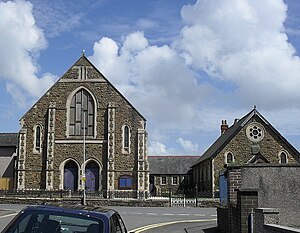
Milford Haven identifies itself as almost exclusively Christian.[66] The earliest known religious building in the area was the Benedictine priory which was dissolved during Henry VIII's reign. Other early buildings included the Catholic St. Thomas a Becket chapel, a later 'beacon church', built around the 12th century which fell into disrepair but was reconsecrated in the 20th century.
The first religious building raised in the foundation of Milford Haven was founded was St Katharine and St Peter. It is considered to be the town's parish church due to its central position within the town and the fact that it was built by Charles Francis Greville the founder of Milford Haven.[67]
- Church in Wales:
- St Katharine and St Peter
- St David's (Hubberston) - a Norman church and is believed to be the oldest building in Milford to be in regular use.[67]
- St. Mary's - built in 1927 largely by money donated by the residents of Hakin.[67]
- Church of the Holy Spirit (1971) (Hakin)
- St Peter and St Cewydd (Steynton)
- Baptist: North Road Baptist Church - one of the older town churches, built in 1878.[67]
- Methodist: Priory Road Methodist Church (1902)
- Society of Friends (Quakers): Friends Meeting House - built in 1811 by the original Quaker whalers who were central to the early growth of the town. Quakers travel from distances around Pembroke to worship at the Friends House.[67]
- United Reformed Church:
- Priory Road Methodist Church (see above)
- Hakin Point
- URC Tabernacle.
- Roman Catholic: St Francis of Assisi
Architecture
Architecture in Milford Haven can be divided into roughly three broad periods of building. The number of buildings which pre-date the town's official foundation in 1790 are scarce. These include the Mediæval priory,[68] and a 12th-century 'beacon chapel'.[69]
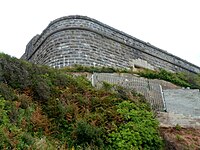
The initial phase of construction from the late 18th century is located in the area central to the town, the three parallel streets of Hamilton Terrace, Charles Street and Robert Street.[9] Three-storey Georgian domestic and commercial properties are set along the northern side of the main road through the town, and overlook the harbour and waterway.[68]
By the late 19th century, the land directly above this central area was being developed. To house the growing population, rows of terrace houses were built, which slowly encompassed the area north up to Marble Hall Road, and east to Pill, examples including Shakespeare Avenue and Starbuck Road.[9] The Great North Road took a northerly route which sliced this new district in two. By the turn of the 20th century, there was a recognized need to provide accommodation to poorer families. As a result, much former agricultural land was bought, and new Council Housing was built.[68] These were frequently in large estates of houses, such as Howarth Close, Haven Drive and The Glebelands Estate. They transformed previously rural areas into an urban landscape, and considerably increased Milford's density. These council estates however have not matched the utopian visions that greeted their arrival and some are prey to serious anti-social incidents.[70][71]
Sights of the town
Attractions in the town include Fort Hubberstone, built in 1863 to defend the Haven as part of the recommendations of the Royal Commission on the Defence of the United Kingdom. Located in Gelliswick bay, it occupies a prominent position to the west of the town overlooking the Haven. Owned by Milford Haven Port Authority, the site is not currently open to the public, and has been the scene of non-fatal injuries to trespassers.[72] In 2011 it was named as the fifth most endangered archaeological site in the United Kingdom by British Archaeology Magazine.[73][74]
The ruins of an observatory, originally intended to be part of "The College of King George the Third founded at Milford", can be found in Hakin. Construction of the building was abandoned in 1809. The town museum, located centrally in the docks area, is housed in the town's oldest building, the Custom House which dates back to 1797. Designed by Swansea architect, Jernigan, it was built for the storage of whale oil awaiting shipment for sale in London.[75]
The Rath is a landscaped street on high ground, with panoramic views of the Haven. The land was used in the 18th century as a gun battery, and its eastern edge was the site of the Royalist fort constructed by Charles I. In the 1930s it became the home of an outdoor swimming pool, which was converted into a water gardens in 1990.
Culture and community
The Torch Theatre, opened in 1977 and designed by local architect Monty Minter, is one of only three repertory theatres in Wales, and possesses its own independent theatre company.[76] Annual events in the town include the Pembrokeshire Fish Week in June,[77] and the carnival in July.[78]
The Milford & West Wales Mercury weekly newspaper covers the Milford Haven and West Pembrokeshire area. It was founded in 1992 and following a merger of its editorial team with that of the Western Telegraph, its local office was closed in 2008.[79]
Milford Haven library, recently relocated to Havens Head Retail Park offers a full lending service and internet access.[80] Milford Haven museum, located in the marina, houses a collection which focusses on the maritime history of the town.[81]
Milford Marina
Milford Marina is the site of the former working docks, rebranded in 1991. It offers retail facilities, the town museum and entertainment.
The Marina itself houses 360 berths for private boats.[82]
Transport
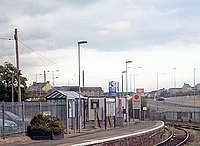
The primary transportation at Milford Haven is by sea, but the port is connected from here by pipelines, by road and by rail.
The main road to the town is the A4076 from Haverfordwest, which connects with the A40.[83] The town centre's road system is based on a grid pattern. The route to Hakin and the western side of the town is along the A4076 via Victoria Bridge over the docks.[84]
The first links to a railway to Milford Haven came through the completion of the South Wales Railway in 1856. Brunel had a vision of connecting London to New York by way of a railway through Wales and then to a commuter port. The initial plan was to terminate the line at Fishguard and to create a ferry service to Ireland, but after a failure to complete Irish rail links the terminus was changed to New Milford, (Neyland), which was completed in April 1856. The first rail link directly to Milford Haven was completed in 1863, which was originally conceived as a plan to create an impressive Milford to Manchester railway. The trains using the line were operated by Great Western Railway who had part funded the original railway.[85]
Today the town in served by Milford Haven railway station which is a terminus from which trains depart every two hours to Manchester Piccadilly by way of Carmarthen, Swansea, and Cardiff Central.
Outside links
| ("Wikimedia Commons" has material about Haven Milford Haven) |
- Milford Haven Town Council
- Milford Haven Port Authority
- Fort Hubberstone
- Milford Haven Mini Site
- Pill Priory - A History
- DigitalDan - Milford Haven
- www.geograph.co.uk : photos of Milford Haven
- Countryside Council for Wales Historic Landscape Map
References
- ↑ 1.0 1.1 One Wales: Connecting the Nation - The Wales Transport Strategy Welsh Assembly Government, April 2008, page 29 Retrieved 17 January 2010
- ↑ Dictionary of the Place-names of Wales. Llandysul: Gomer Press. p. 321. ISBN 9781843239017.
- ↑ Cite error: Invalid
<ref>tag; no text was provided for refs namedBBC placenames - ↑ 4.0 4.1 4.2 4.3 4.4 4.5 4.6 4.7 4.8 "Milford Haven Waterway". Countryside Council for Wales. http://www.ccw.gov.uk/landscape--wildlife/protecting-our-landscape/historic-landscapes/milford-haven-waterway.aspx. Retrieved 15 January 2010.
- ↑ Conduit, Brian (1998). Pembrokeshire and Gower Walks. Pathfinder Guide. Norwich: Jarrold Publishing and Ordnance Survey. p. 11. ISBN 0711706115.
- ↑ "Mudflats". Pembrokeshire Biodiversity Partnership. http://www.biodiversitypembrokeshire.org.uk/publications/Mudflats%20HAP.pdf. Retrieved 17 January 2010.
- ↑ "Historic Landscape Characterisation - Milford Haven". Dyfed Archaeological Trust. http://www.dyfedarchaeology.org.uk/HLC/milford/area/307.htm. Retrieved 15 January 2010.
- ↑ Welsh Tourist Board Weather
- ↑ 9.00 9.01 9.02 9.03 9.04 9.05 9.06 9.07 9.08 9.09 9.10 9.11 9.12 9.13 Wing Commander Ken McKay A Vision Of Greatness: The History of Milford 1790-1990, Brace Harvatt Associates, 1989. ISBN 9780951521205
- ↑ 10.0 10.1 4 August 1649 Timeline: British Civil wars Retrieved 19 January 2010
- ↑ Milford Haven Town Council website History, Chronology of Events Retrieved 17 January 2010
- ↑ Medieval Works Found At LNG Site BBC News Article, 5 April 2005 Retrieved 17 January 2010
- ↑ A History - The 12th Century: Pill Priory - Tironian House, Retrieved 17 January 2010
- ↑ A Topographical Dictionary of Wales, Lewis, Samuel (1849) pp. 374-384 Retrieved 17 January 2010
- ↑ McKay & Springer. Milford Haven Waterway & Town, Tempus Publishing Ltd, 1999. ISBN 978-0-75-241589-5
- ↑ Cymbeline Act 3, Scene 2
- ↑ Genealogy World - Fort Hubberstone Mason, Graham, Retrieved 20 May 2011
- ↑ Owen, George. The Description of Pembrokeshire, Gomer Press, 1994. ISBN 9781859021200
- ↑ Jones, J Gwynfor. Wales & The Tudor State, Cardiff University of Wales Press, 1989. ISBN 0-7083-1039-7
- ↑ Hoyt, Epaphras Antiquarian Researches: Comprising A History Of The Indian Wars In The Country Bordering The Connecticut River, Kessinger Publishing, 2007. ISBN 0-5482-5343-9
- ↑ 1643-4: Civil War in Pembrokeshire Retrieved 18 January 2010
- ↑ BBC, A Short History of Ireland ‘The righteous judgement of God’: Cromwell Retrieved 19 January 2010
- ↑ George, Barbara J; Pembrokeshire Sea Trading Before 1900 Field Studies Journal; Pg, 5-6; Retrieved 19 January 2010
- ↑ 24.0 24.1 BBC South West Wales website 'A Brief History of Milford', Jon Gower Retrieved 19 January 2010
- ↑ David Barnes. The Companion Guide to Wales, Companion Guides, 2005. ISBN 9781900639439
- ↑ Encyclopedia Britannica: Milford Haven Retrieved 30 January 2010
- ↑ Edwards, Sybil, The Story of the Milford Haven Waterway, Logaston Press, 2009. ISBN 9781906663100
- ↑ "Archaeology in Wales - Ymddiriedolaeth Archaeolegol Dyfed - Dyfed Archaeological Trust". www.cambria.org.uk. http://www.cambria.org.uk/HLC/milford/area/307.htm. Retrieved 2010-02-10.
- ↑ Francis Barrallier A_Life in Context icahistcarto.org
- ↑ Rees, Thomas, The Beauties of England and Wales, or, Delineations, topographical, historical, and descriptive, of each county, Vernor & Hood, 1803 ASIN: B0018X3YSI
- ↑ National Library of Wales Journal. 1977, Summer Volume XX/1 (from GENUKI.org) Retrieved 30 January 2010
- ↑ Extract from Bartholomew, John (1887) 'Gazetteer of the British Isles' from Vision of Britain.org] Retrieved 30 January 2010
- ↑ Record Office, from 'Archives Network Wales' Retrieved 30 January 2010
- ↑ [1] Lewis, Samuel (1849) A Topographical Dictionary of Wales pp. 430-440. From British History Online] Retrieved 30 january 2010
- ↑ Vision of Britain Descriptive Gazetteer entry for MILFORD", Wilson, John Marius (1870-1872). Retrieved 20 January 2010
- ↑ 'The Great Eastern' New York Times, 23 May 1886 Retrieved 20 January 2010
- ↑ Palmerston Forts Society Retrieved 20 january 2010
- ↑ Palmerston Forts Society Retrieved 20 January 2010
- ↑ Milford Haven UD: Total Population A Vision of Britain Through Time: Population Statistics
- ↑ "Experience Pembrokeshire Website" Retrieved 30 January 2010
- ↑ Richards, Bill, Pembrokeshire Under Fire: The Story Of The Air Raids OF 1940-1, Paterchurch Publications, 1995. ISBN 1-8707-4505-1
- ↑ BBC News: The Sea Empress Disaster Retrieved 30 January 2010
- ↑ Hughes, Wendy. The Story of Pembrokeshire, Gwasg Carreg Gwalch, 1993. ISBN 0-86381-253-8
- ↑ "Sandy Haven to Milford Haven coastal walk". Walk through time. BBC. http://www.bbc.co.uk/wales/southwest/sites/nhob_walk/includes/walk_printout.sssi?1. Retrieved 2009-01-15.
- ↑ "First liquid gas delivery in port". BBC Wales. 2009-03-20. http://news.bbc.co.uk/1/hi/wales/south_west/7952415.stm. Retrieved 2009-03-20.
- ↑ "Ship cruises in for record visit". BBC News. 24 July 2008. http://news.bbc.co.uk/1/hi/wales/south_west/7519016.stm. Retrieved 2009-01-15.
- ↑ KS01 Usual Resident Population: Census 2001 'Key Statistics for Urban Areas', Office For National Statistics D8271.xls (PDF) line 2540 Retrieved 17 January 2010
- ↑ Settlement Populations, Pembrokeshire County Council 2001 Census Retrieved 17 January 2010
- ↑ "Wave power plan for Welsh coast". BBC News. 15 December 2005. http://news.bbc.co.uk/1/hi/wales/south_west/4528946.stm. Retrieved 2009-01-15.
- ↑ Warburton, Jack Milford Haven in Old Picture Postcards, Zaltbommel, Netherlands, 1984. ISBN 90-288-2769-2
- ↑ A Vision of Britain Through Time: Occupation Statistics Retrieved 20 January 2010
- ↑ Hansard Extract - HC Deb 30 July 1959 vol 610 cc731-48 - Industrial Development, Milford Haven Retrieved 02 January 2011
- ↑ The Guardian, 27 April 2007 - How green was my valley Retrieved 30 January 2010
- ↑ Timeline: LNG plants in Wales BBC News article: 19 March 2009
- ↑ Ship Cruises In For Record Visit BBC News article: Ship Cruises In For Record Visit, 24 July 2008
- ↑ Milford Haven Port Authority Retrieved 20 January 2010
- ↑ Davies, John. A History of Wales, Penguin Books, 1994. ISBN 978-0-14-014581-6
- ↑ "Tall Ships bid for Wales". BBC News. 4 February 2001. http://news.bbc.co.uk/1/hi/wales/1152835.stm. Retrieved 14 January 2010.
- ↑ "Milford Marina - Understanding the value of your recreation time". Milford Haven Port Authority. http://www.mhpa.co.uk/content.asp?article_id=1116&directory_id=1&d=16. Retrieved 23 January 2010.
- ↑ "Milford Haven Information Centre". Pembrokeshire County Council. 17 August 2010. http://www.pembrokeshire.gov.uk/content.asp?id=10487&nav=103,949,954,958&parent_directory_id=646. Retrieved 17 August 2010.
- ↑ "Milford Haven Heritage and Maritime Museum". Culture 24. http://www.culture24.org.uk/wa000049. Retrieved 23 January 2010.
- ↑ Davies, p.659
- ↑ ONS 2001 Census Statistics Retrieved 20 january 2010
- ↑ Haselden, Lucy (2003) Differences in estimates of Welsh Language Skills Ethnicity and Identity Branch, ONS p.11 Retrieved 20 January 2010
- ↑ BBC News: Town wants Welsh language opt-out Retrieved 20 January 2010
- ↑ ONS: Neighbourhood Statistics - Religion Retrieved January 2010
- ↑ 67.0 67.1 67.2 67.3 67.4 Milford Haven Town Council: Worship Retrieved 19 January 2010
- ↑ 68.0 68.1 68.2 Milford Haven historic background dyfedarchaeology.org.uk Retrieved 20 January 2010
- ↑ Sandy Haven to Milford Haven coastal walk bbc.co.uk
- ↑ 'Nuisances' evicted from estate BBC News Article: 20 July 2003
- ↑ Teenagers 'Taunted' Dead Man BBC News Article: 18 October 2000
- ↑ Milford & West Wales Mercury, 18 August 2005 Retrieved 30 January 2010
- ↑ 6 Threatened Sites British Archaeology Magazine Article, www.britarch.ac.uk, accessed 30th June 2011
- ↑ Hubberstone Fort is one of Britain’s most endangered archaeological sites Article, www.WalesOnline.co.uk, 26th April 2011
- ↑ Pembrokeshire Virtual Museum - Milford Haven Museum, Retrieved 7 February 2010
- ↑ Torch Theatre history Retrieved 19 January 2010
- ↑ Pembrokeshire County Council: Pembrokeshire Fish Weekend Retrieved 19 January 2010
- ↑ Milford Haven Round Table: Carnival Retrieved 03 July 2011
- ↑ "Milford & West Wales Mercury". www.britishpapers.co.uk. http://www.britishpapers.co.uk/wales/milford-west-wales-mercury/. Retrieved 30 January 2010.
- ↑ County Council Libraries Retrieved 19 January 2010
- ↑ Milford Haven Museum Retrieved January 2010
- ↑ Milford Haven Port Authority Retrieved 30 January 2010
- ↑ "A4076 - Roader's Digest: The SABRE Wiki". www.sabre-roads.org.uk. http://www.sabre-roads.org.uk/wiki/index.php?title=A4076. Retrieved 2010-02-10.
- ↑ "Statutory Instrument 1998 No. 112". 195.99.1.70. http://195.99.1.70/si/si1998/19980112.htm. Retrieved 2010-02-10.
- ↑ laluciole.net: A history of Britain's broad gauge railways Retrieved 30 january 2010
- Davies, John; Jenkins, Nigel (2008). The Welsh Academy Encyclopaedia of Wales. Cardiff: University of Wales Press. ISBN 9780708319536.
- McKay, Ken (1989). A Vision Of Greatness: The History of Milford 1790-1990. Milford Haven: Brace Harvatt Associates. ISBN 9780951521205.
- Richards, Bill (1995). Pembrokeshire Under Fire: The Story Of The Air Raids Of 1940-1. Pembroke Dock: Paterchurch Publications. ISBN 1870745051.
- Warburton, Jack (1994). Milford Haven in Old Picture Postcards. Netherlands: Zaltbommel,. ISBN 90-288-2769-2.
